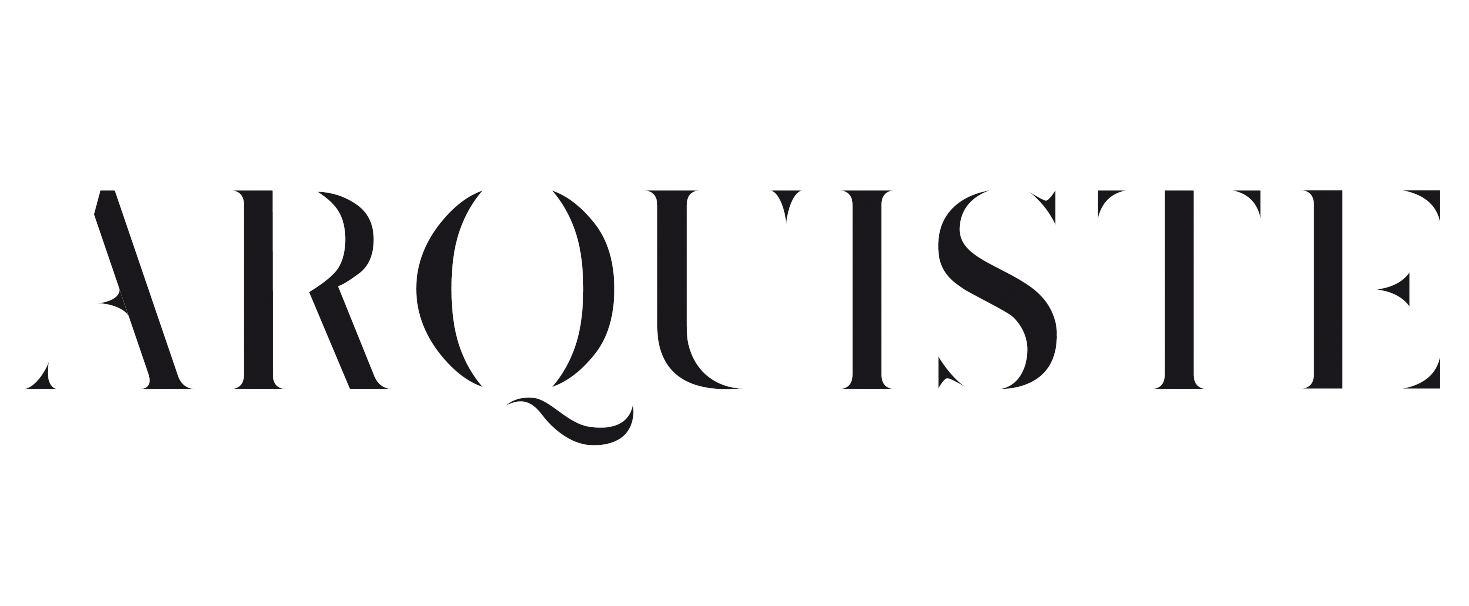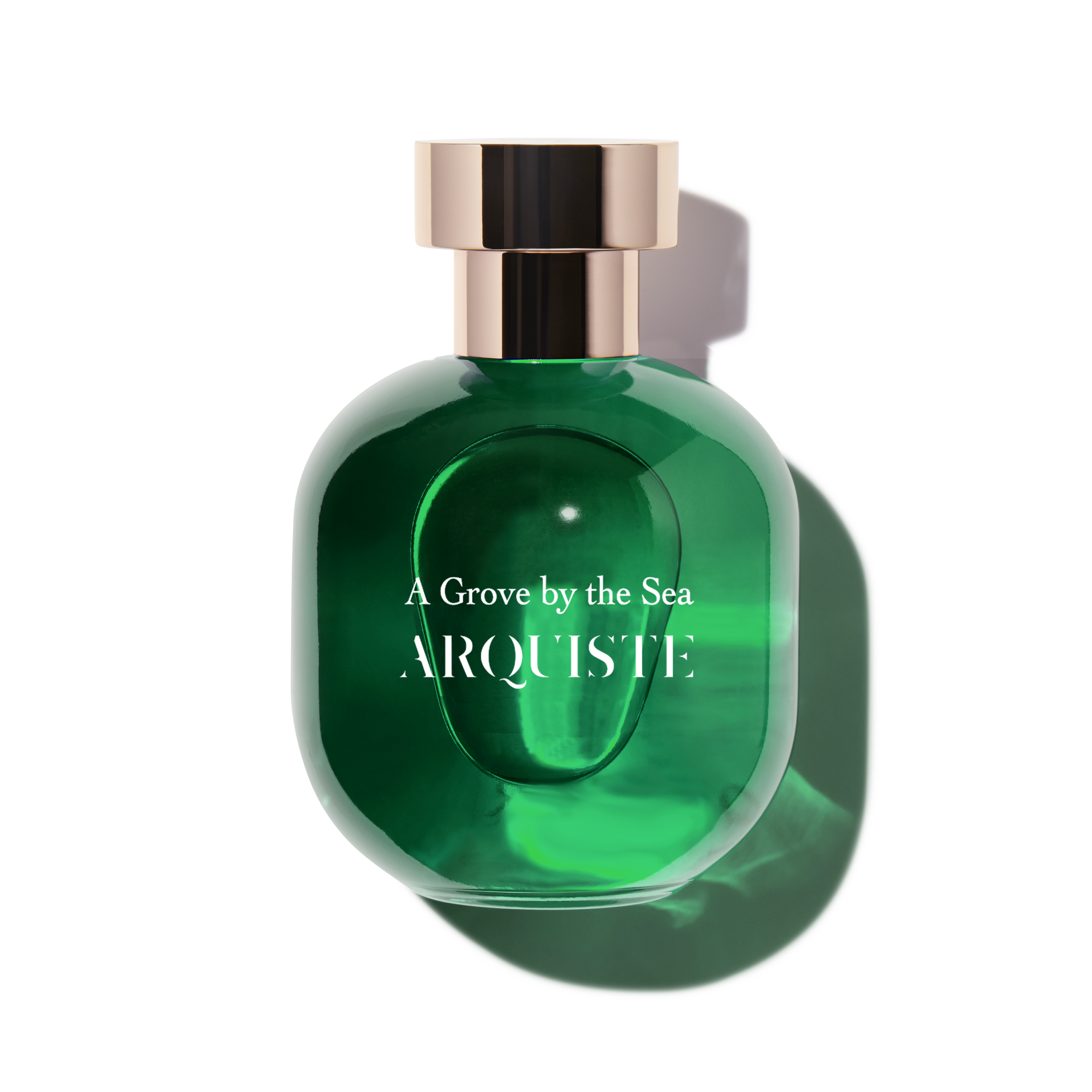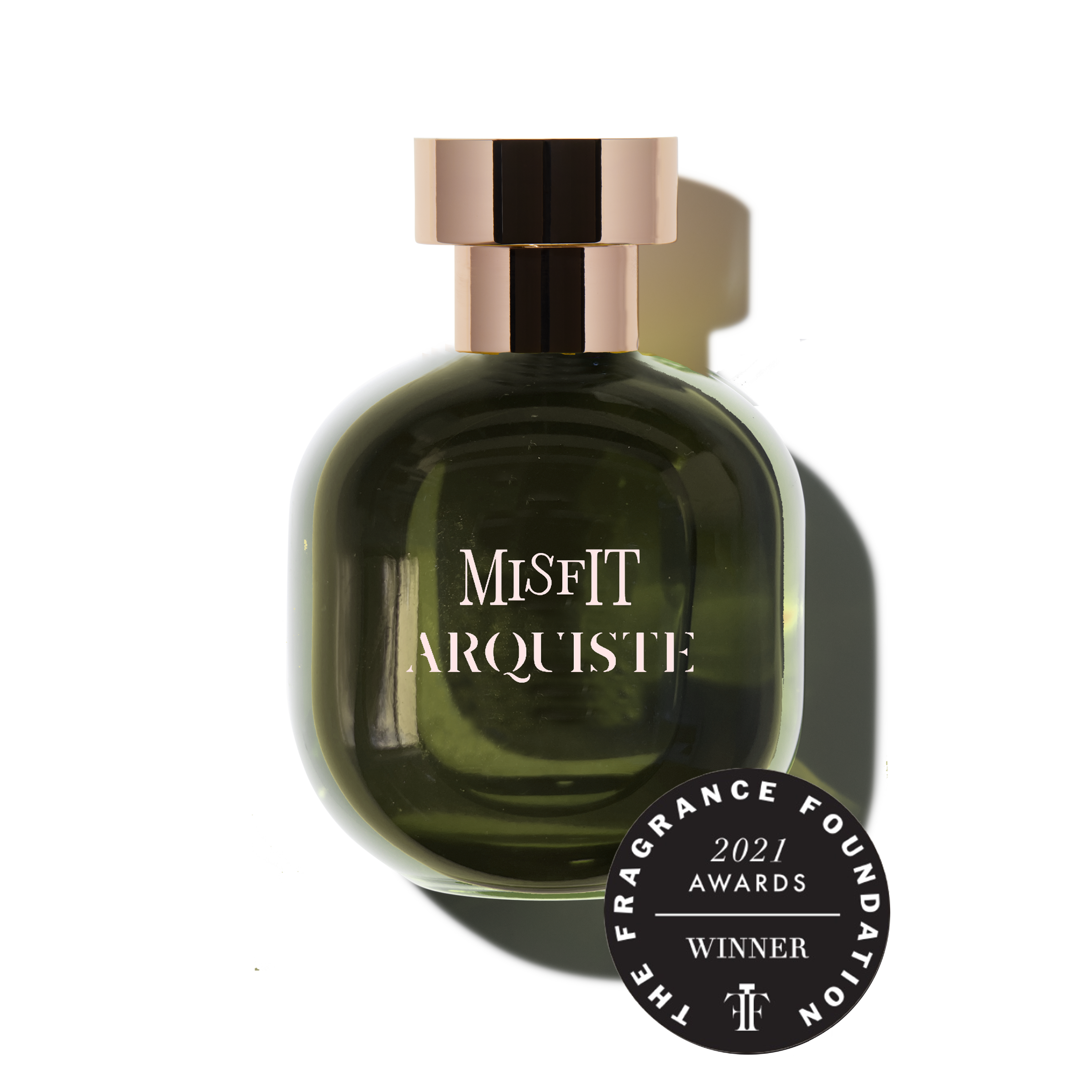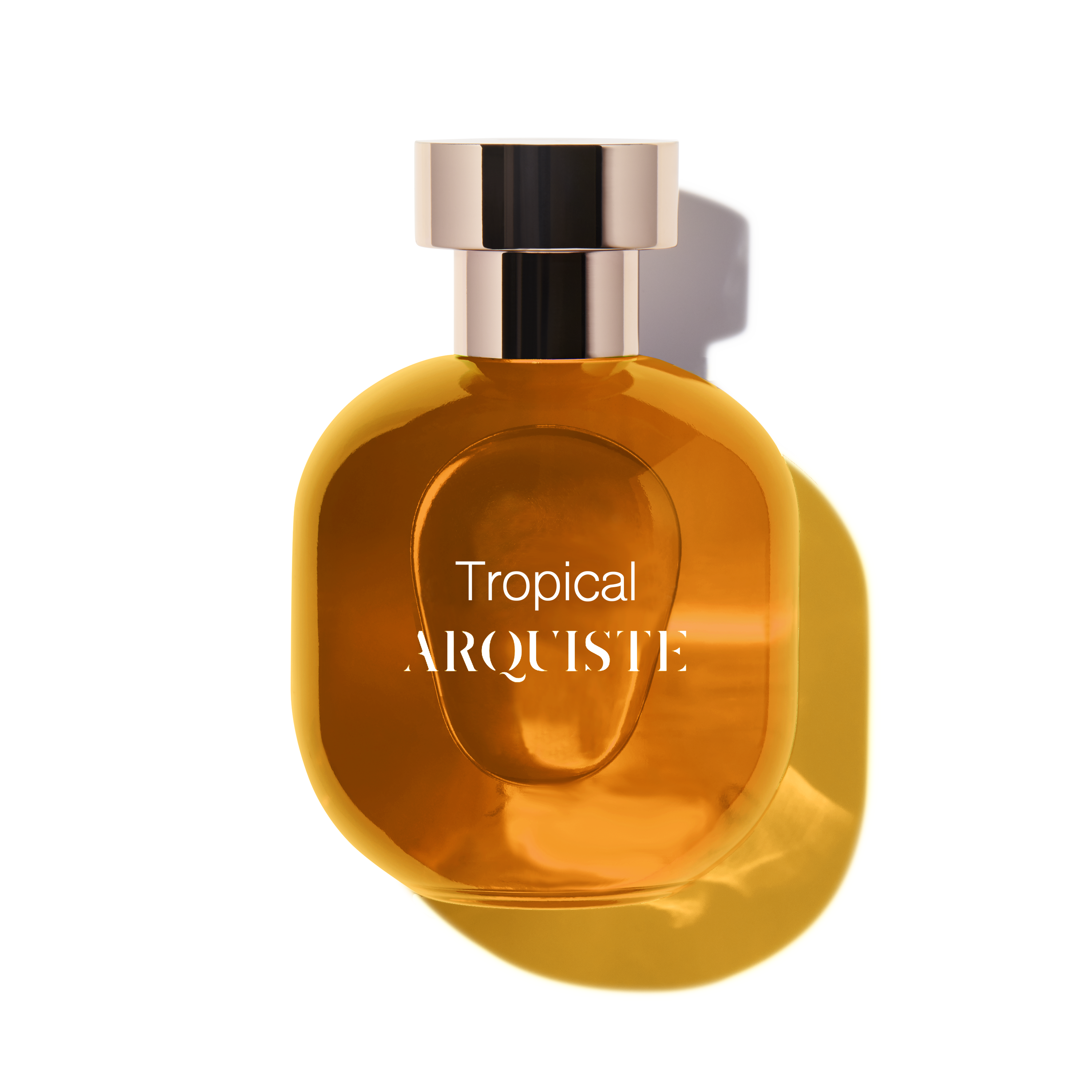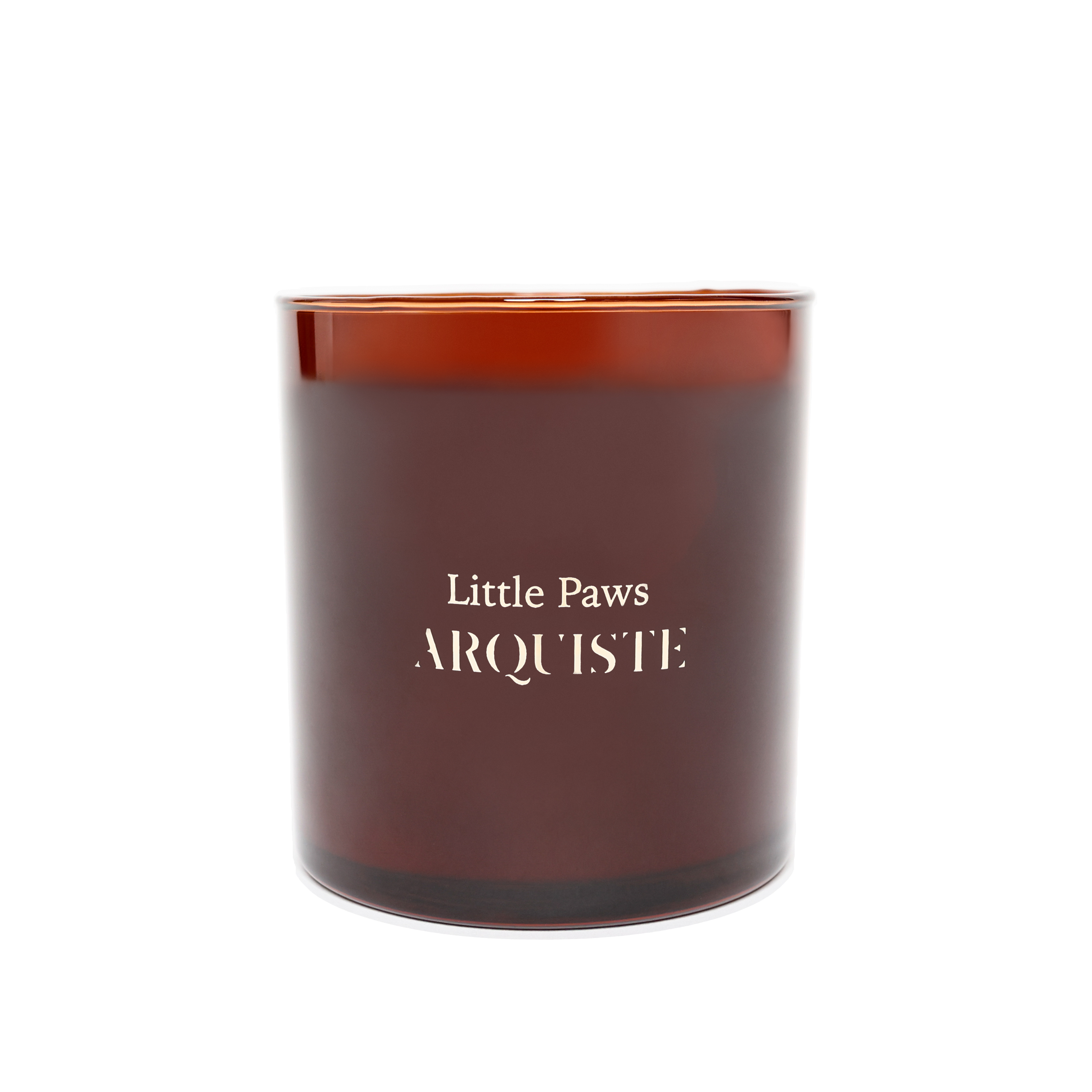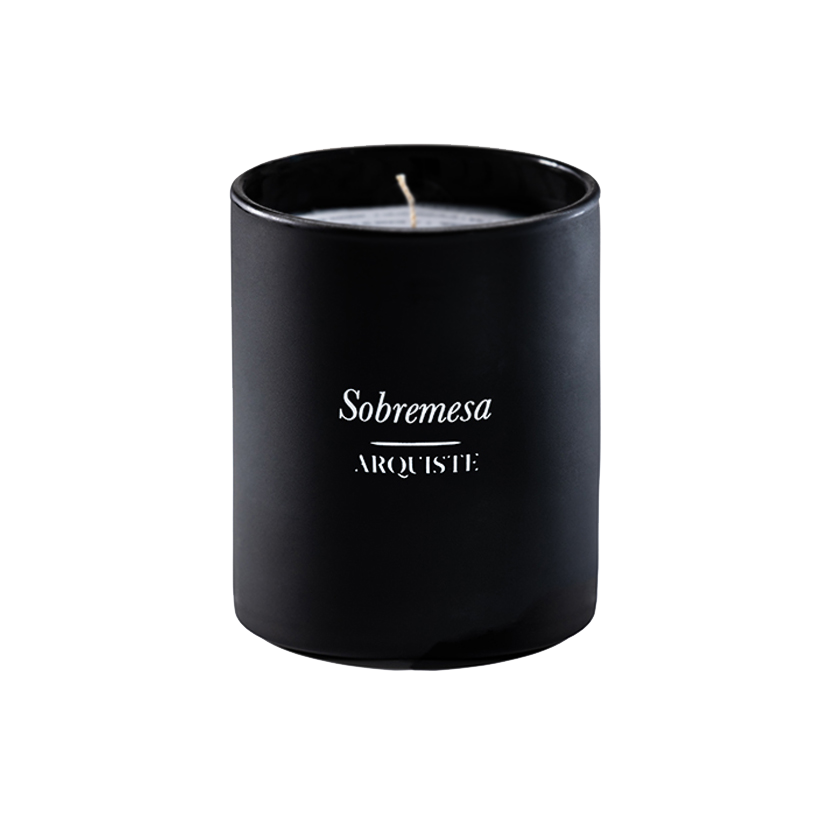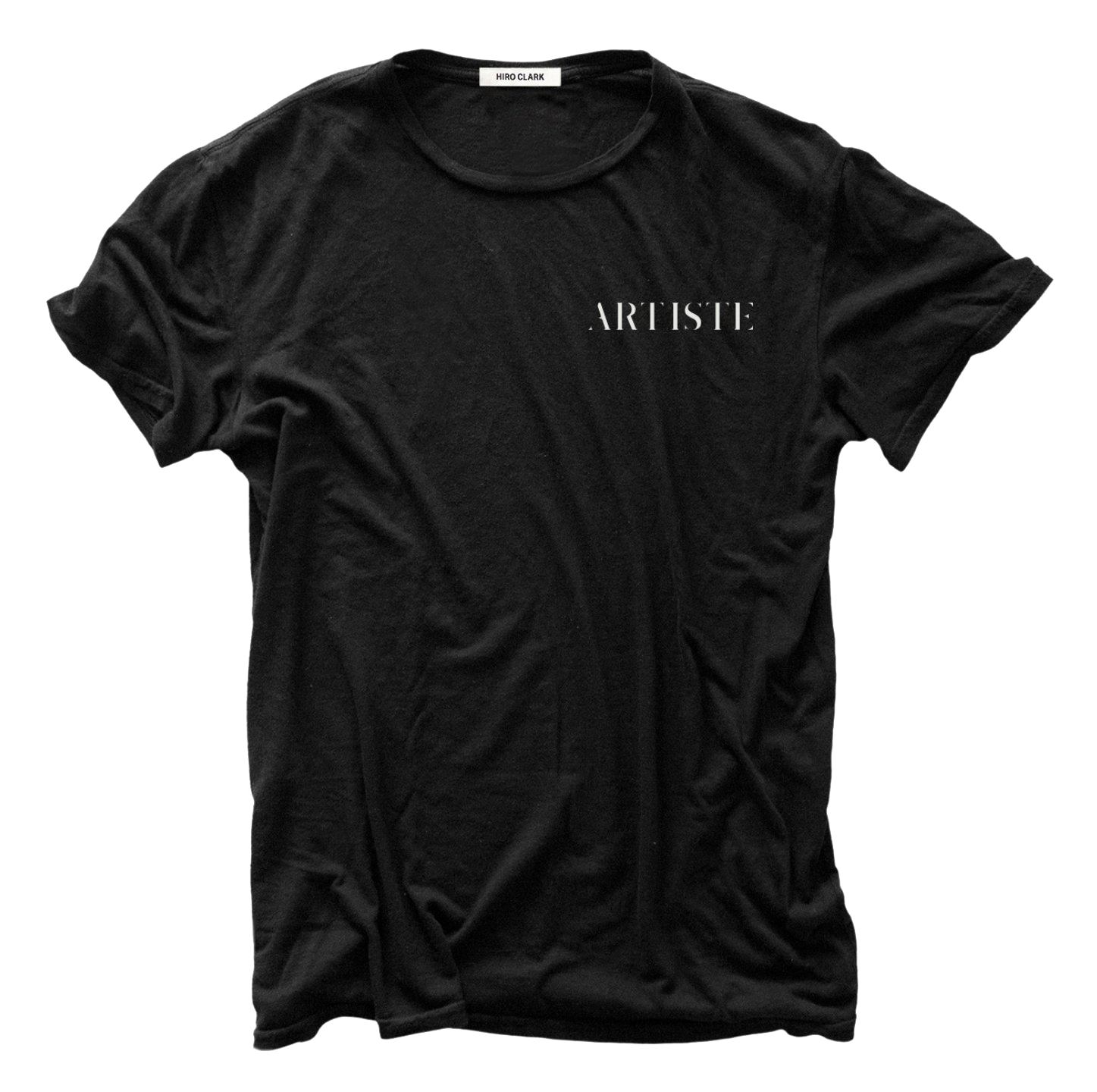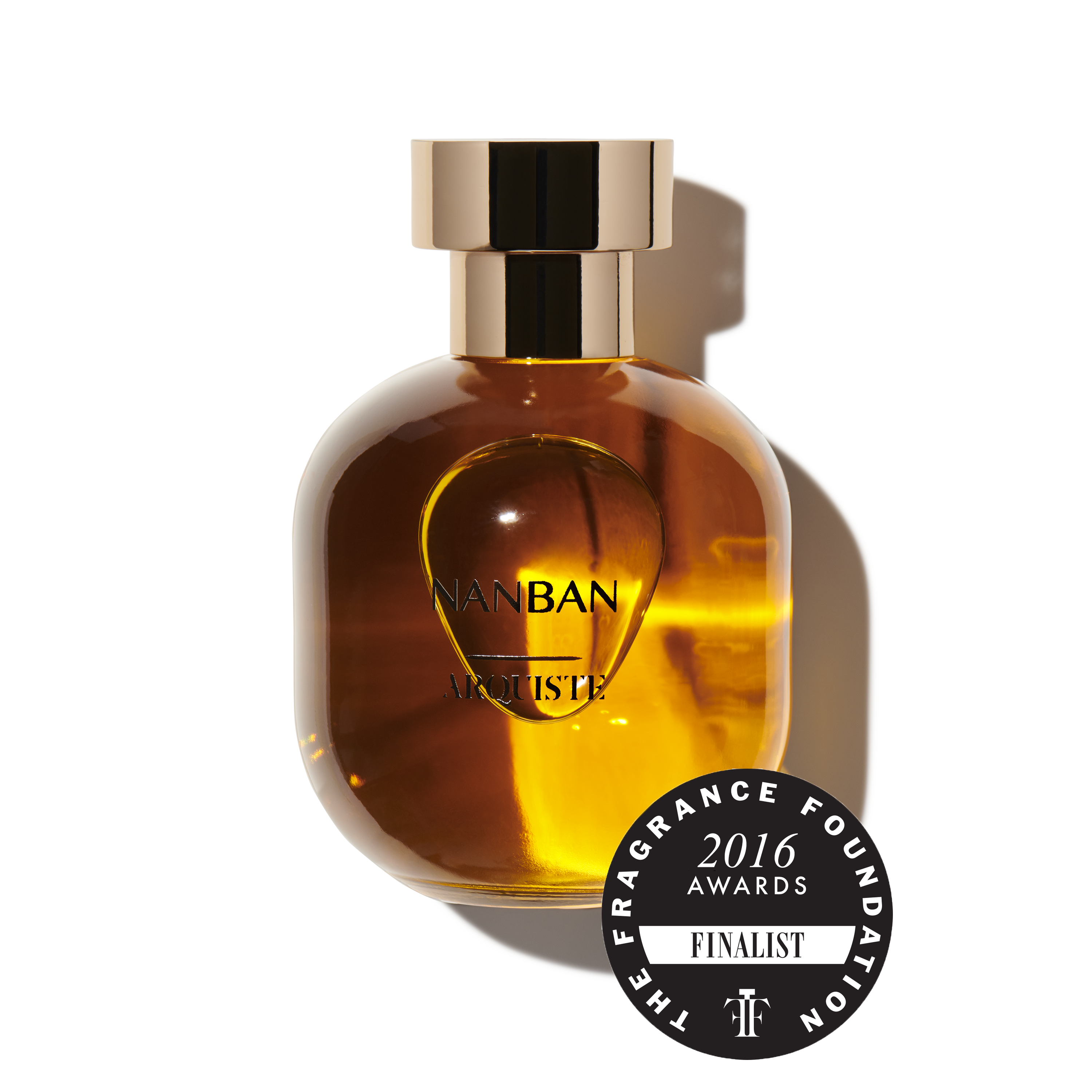
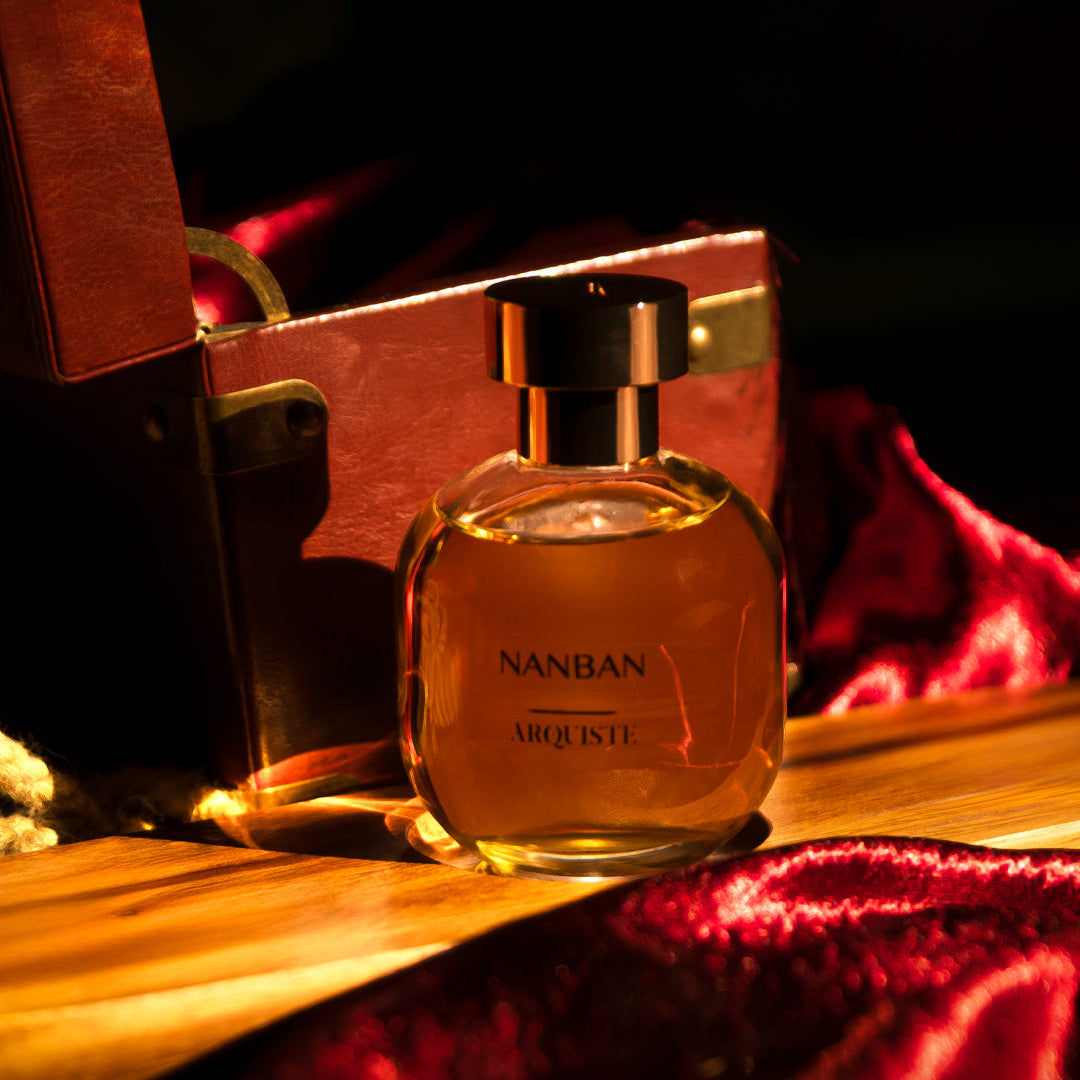
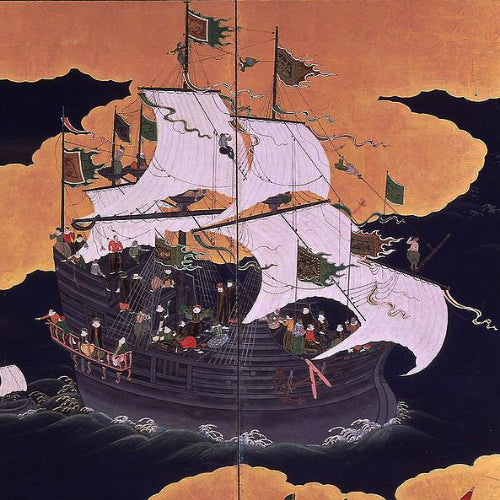
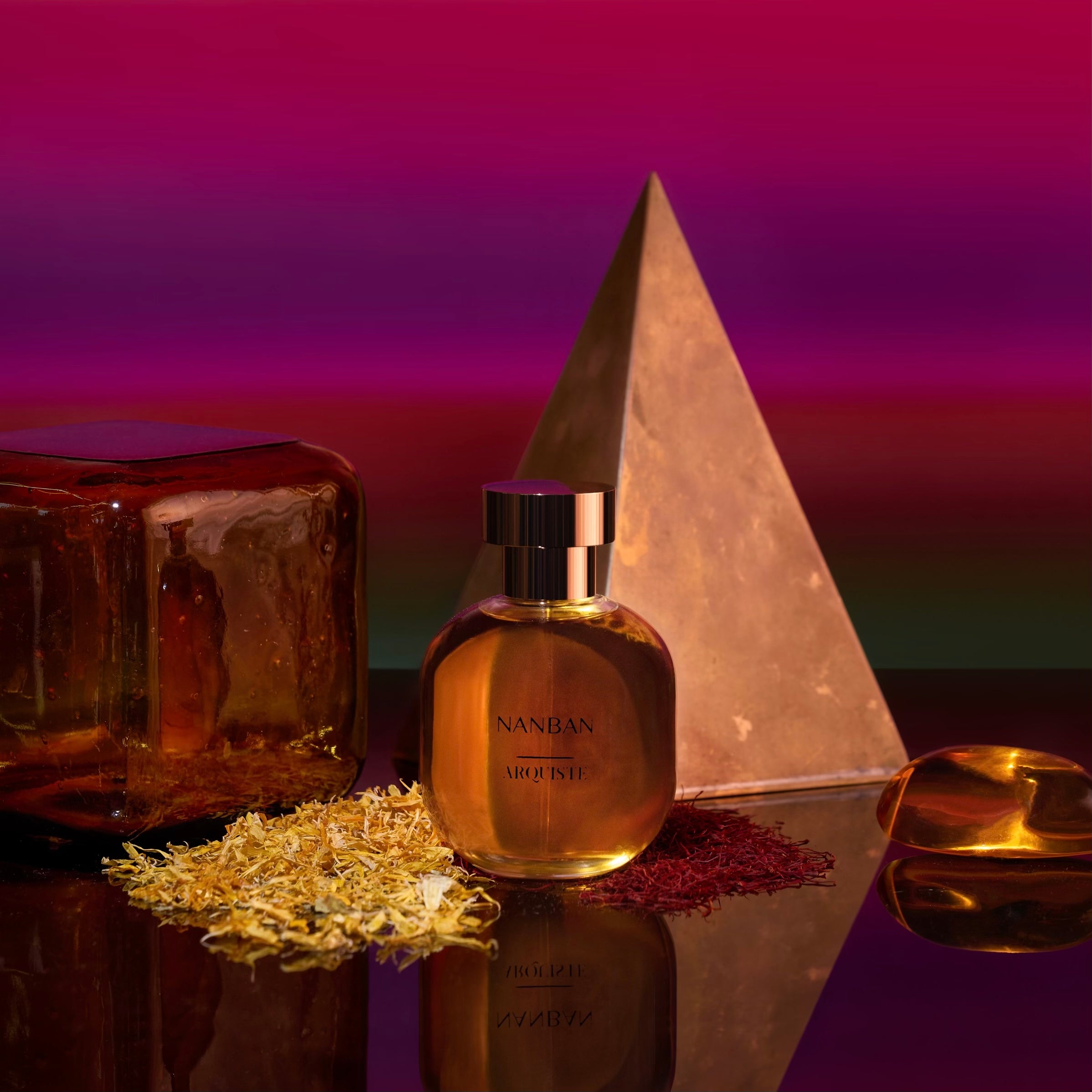
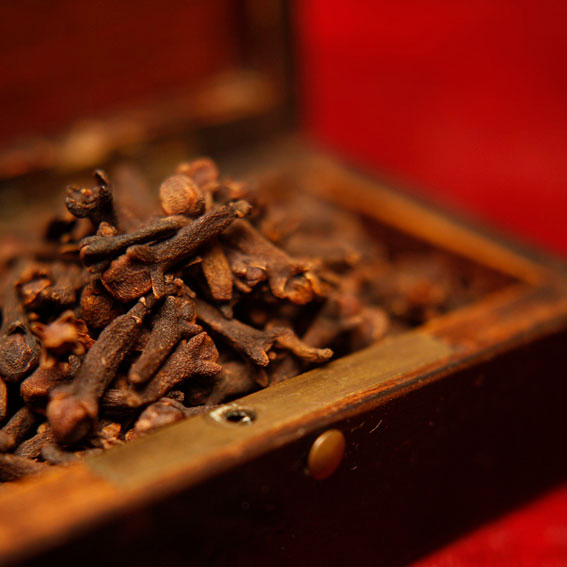
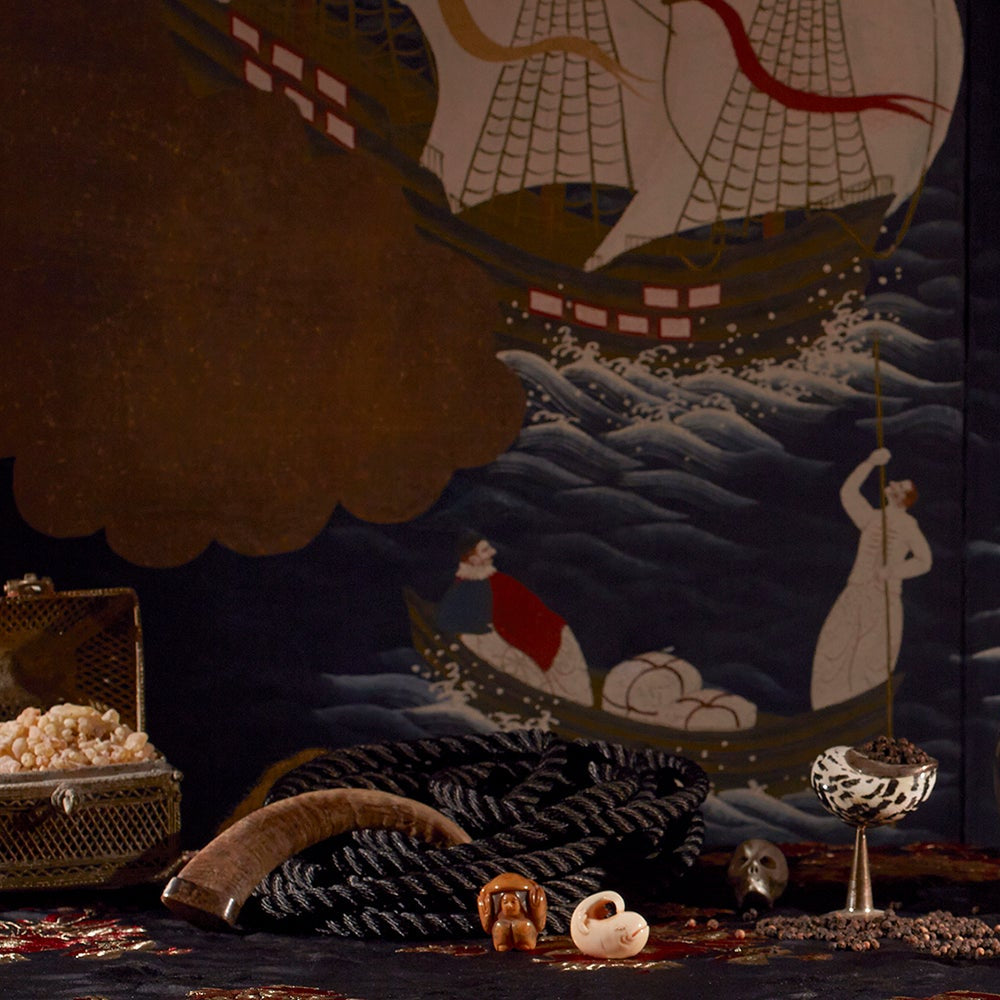
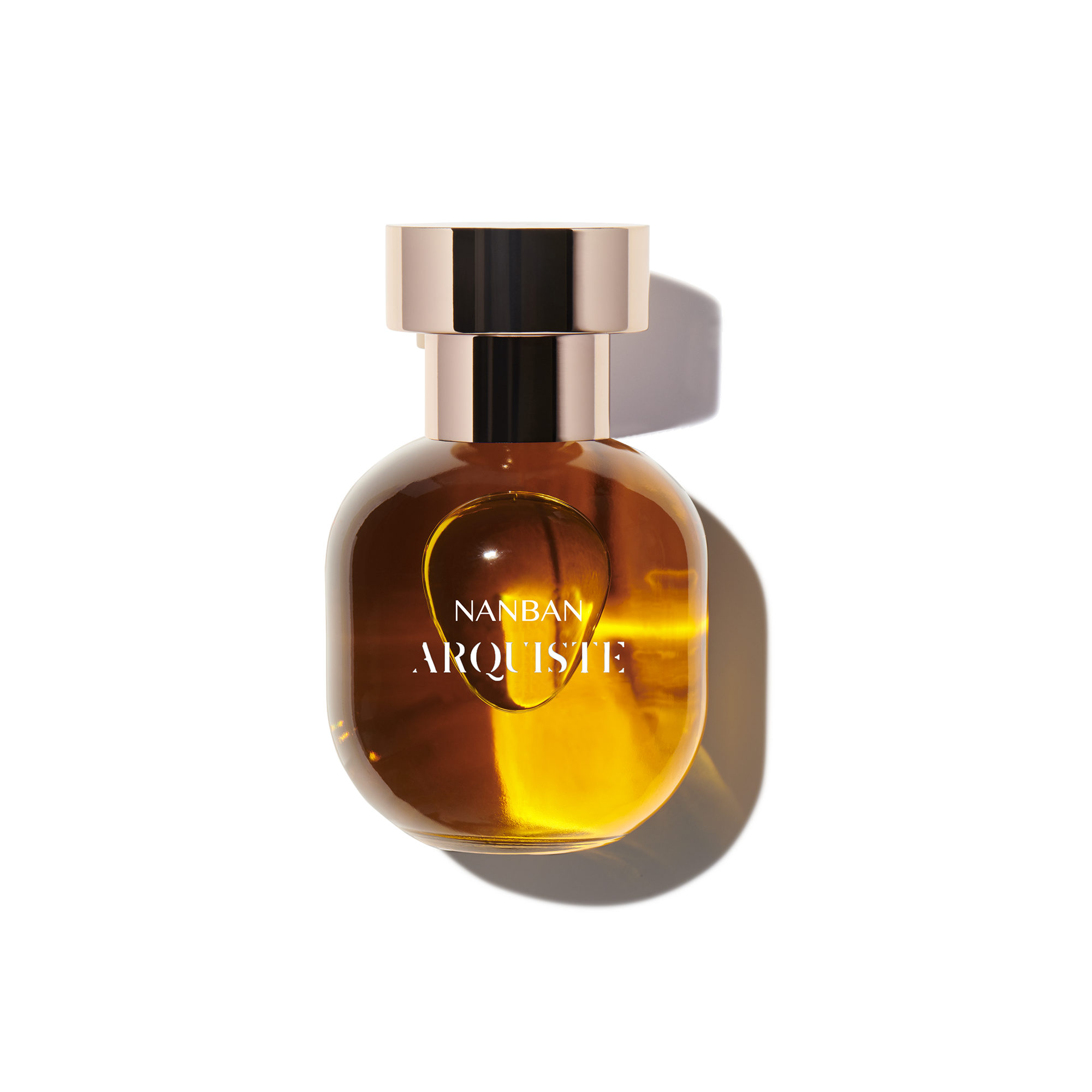
Top Notes
Malabar black pepper
Persian saffron
Black tea accord
Chinese osmanthus
Heart Notes
Coffee absolute
Spanish leather
Sandalwood
Myrrh
Base Notes
Frankincense
Styrax
Copaiba balsam
Cade
Intro
An intoxicating incense and leather scent based on the ancient commercial trade between Asia, Europe and the Americas, with a spicy, sensual opening and a lush, robust incense base. Inspired by a 1618 voyage uniting East and West, NANBAN is transports you to the dark hull of a galleon full of exotic cargo. With notes of: Malabar black pepper, Persian saffron, Chinese osmanthus, coffee absolute, Spanish leather, myrrh, frankincense, sandalwood and cade.
Eau de Parfum
History
January 1618, a Japanese galleon, the Pacific ocean.
Following a diplomatic mission to the West, a galleon carrying a delegation of samurai charges through dark ocean currents. Loaded with a rare and precious cargo, the ship’s hull is redolent of sweet-smelling tropical woods, heady Spanish leather, frankincense, fine black pepper and other exotic ground spices—the intoxicating spirit of a singular, extraordinary voyage of discovery.
Developed with Rodrigo Flores-Roux.
Description
An intoxicating incense and leather based scent on the ancient commercial trade between Asia, Europe and the Americas, with a spicy, sensual opening and a lush, robust incense base.
The signature ARQUISTE design consists of an ergonomic round bottle that feels great in your hands. Made of the highest quality glass in Parma, Italy, its complemented by a high-quality engraved metal cap, a fine mist spray pump and the newest technology for a crystal spray tube.
More
- The pitch black hull of the galleon carried exotic goods like European leather, fine oil paintings and carved woodwork, rich spices from South East Asia and silver, cacao and coffee from Mexico. It was the last commercial and diplomatic excursion to the West until the 19th century. After this epic mission, Japan closed its borders to foreign influence, due to its mistrust of Catholic missionaries. Hasekura Tsunenaga’s journey represents a unique and almost forgotten moment in history, one never to be repeated.
- Nanban (南蛮, “southern barbarian”) is a Sino-Japanese word, originally referring to foreigners arriving to Japan from the south sea. In Japan, the word took on a new meaning when it came to designate the Portuguese and Spanish, who first arrived in 1543, and later other Europeans. Today it’s used more as a historic designation, referring especially to 16th and 17th century art and decorative objects with a European influence.
- The fragrance of NANBAN represents a Japanese story outside of the traditional vision of the country. It’s not Japanese in style because it composed of ingredients from Europe, South East Asia and Mexico alien to Japanese culture, but that were brought into the country by the 17th century delegation. A ‘foreign-style’ (i.e. Nanban style) fragrance representing a novel view of the West, and vice-versa.
Bio
– Massarella, Derek, Japanese Travelers in Sixteenth-century Europe: A Dialogue Concerning the Mission of the Japanese Ambassadors to the Roman Curia (1590), Ashgate Publishing, Ltd., January 28, 2013.
– Lidin, Olof G., Tanegashima – The Arrival of Europe in Japan.Routledge, 2002.
– Moran, J.F., The Japanese and the Jesuits, Routledge, 2012.
– Sakamoto Mitsuru et al., Nanban byobu shusei (Compendium of Nanban screens), Tokyo, Chuo Koron Bijutsu Shuppan, 2008.
– Nelson, Thomas, Monumenta Nipponica: Studies on Japanese Culture, Past and Present, Volume 59, Issues 3-4, Sophia University, 2004.
– Boxer, C.R. The Christian Century in Japan, 1549–1650, Berkeley, California: University of California Press, 1951. (1993 reprint edition).
– Marcouin, Francis and Keiko Omoto. Quand le Japon s’ouvrit au monde, Paris: Découvertes Gallimard, 1990.
– Hayes, Derek, Historical atlas of the North Pacific Ocean: maps of discovery and scientific exploration, 1500–2000, Seattle, Washington: Sasquatch Books. 2001.
– Annals of His Time: Don Domingo De San Anton Munon Chimalpahin Quauhtlehuanitzin, Stanford University Press 2006.
– Sotelo, Luis, De ecclesiae Iaponicae statu relatio
– Endo, Shusaku, The Samurai, New Directions Publishing Corporation, Reprint edition, april 1997. (A slightly fictional account of Hasekura’s expedition).
– The World and Japan – Tensho and Keicho missions to Europe 16th – 17th century “世界と日本ー天正・慶長の使節, 1995, Sendai City Museum (Japanese)
– Date Masamune’s Mission to Rome in 1615 国宝「慶長遣欧使節関係資料, Catalogue of Sendai City Museum, 2001. (Japanese)
Image

NANBAN
Payment Methods





Shipping
ARQUISTE ships exclusively within the continental United States.
Please allow 1-3 days for us to receive and process your order during busy seasons. East Coast customers: Please add 3-4 business days after order processing. Central and West coast customers: 5-7 business days after order processing. To avoid delays or lost packages ARQUISTE® strongly recommends adding package protection to your order and shipping with UPS Ground.









NANBAN
Top Notes
Malabar black pepper
Persian saffron
Black tea accord
Chinese osmanthus
Heart Notes
Coffee absolute
Spanish leather
Sandalwood
Myrrh
Base Notes
Frankincense
Styrax
Copaiba balsam
Cade
Intro
An intoxicating incense and leather scent based on the ancient commercial trade between Asia, Europe and the Americas, with a spicy, sensual opening and a lush, robust incense base. Inspired by a 1618 voyage uniting East and West, NANBAN is transports you to the dark hull of a galleon full of exotic cargo. With notes of: Malabar black pepper, Persian saffron, Chinese osmanthus, coffee absolute, Spanish leather, myrrh, frankincense, sandalwood and cade.
Eau de Parfum
History
January 1618, a Japanese galleon, the Pacific ocean.
Following a diplomatic mission to the West, a galleon carrying a delegation of samurai charges through dark ocean currents. Loaded with a rare and precious cargo, the ship’s hull is redolent of sweet-smelling tropical woods, heady Spanish leather, frankincense, fine black pepper and other exotic ground spices—the intoxicating spirit of a singular, extraordinary voyage of discovery.
Developed with Rodrigo Flores-Roux.
Description
An intoxicating incense and leather based scent on the ancient commercial trade between Asia, Europe and the Americas, with a spicy, sensual opening and a lush, robust incense base.
The signature ARQUISTE design consists of an ergonomic round bottle that feels great in your hands. Made of the highest quality glass in Parma, Italy, its complemented by a high-quality engraved metal cap, a fine mist spray pump and the newest technology for a crystal spray tube.
More
- The pitch black hull of the galleon carried exotic goods like European leather, fine oil paintings and carved woodwork, rich spices from South East Asia and silver, cacao and coffee from Mexico. It was the last commercial and diplomatic excursion to the West until the 19th century. After this epic mission, Japan closed its borders to foreign influence, due to its mistrust of Catholic missionaries. Hasekura Tsunenaga’s journey represents a unique and almost forgotten moment in history, one never to be repeated.
- Nanban (南蛮, “southern barbarian”) is a Sino-Japanese word, originally referring to foreigners arriving to Japan from the south sea. In Japan, the word took on a new meaning when it came to designate the Portuguese and Spanish, who first arrived in 1543, and later other Europeans. Today it’s used more as a historic designation, referring especially to 16th and 17th century art and decorative objects with a European influence.
- The fragrance of NANBAN represents a Japanese story outside of the traditional vision of the country. It’s not Japanese in style because it composed of ingredients from Europe, South East Asia and Mexico alien to Japanese culture, but that were brought into the country by the 17th century delegation. A ‘foreign-style’ (i.e. Nanban style) fragrance representing a novel view of the West, and vice-versa.
Bio
– Massarella, Derek, Japanese Travelers in Sixteenth-century Europe: A Dialogue Concerning the Mission of the Japanese Ambassadors to the Roman Curia (1590), Ashgate Publishing, Ltd., January 28, 2013.
– Lidin, Olof G., Tanegashima – The Arrival of Europe in Japan.Routledge, 2002.
– Moran, J.F., The Japanese and the Jesuits, Routledge, 2012.
– Sakamoto Mitsuru et al., Nanban byobu shusei (Compendium of Nanban screens), Tokyo, Chuo Koron Bijutsu Shuppan, 2008.
– Nelson, Thomas, Monumenta Nipponica: Studies on Japanese Culture, Past and Present, Volume 59, Issues 3-4, Sophia University, 2004.
– Boxer, C.R. The Christian Century in Japan, 1549–1650, Berkeley, California: University of California Press, 1951. (1993 reprint edition).
– Marcouin, Francis and Keiko Omoto. Quand le Japon s’ouvrit au monde, Paris: Découvertes Gallimard, 1990.
– Hayes, Derek, Historical atlas of the North Pacific Ocean: maps of discovery and scientific exploration, 1500–2000, Seattle, Washington: Sasquatch Books. 2001.
– Annals of His Time: Don Domingo De San Anton Munon Chimalpahin Quauhtlehuanitzin, Stanford University Press 2006.
– Sotelo, Luis, De ecclesiae Iaponicae statu relatio
– Endo, Shusaku, The Samurai, New Directions Publishing Corporation, Reprint edition, april 1997. (A slightly fictional account of Hasekura’s expedition).
– The World and Japan – Tensho and Keicho missions to Europe 16th – 17th century “世界と日本ー天正・慶長の使節, 1995, Sendai City Museum (Japanese)
– Date Masamune’s Mission to Rome in 1615 国宝「慶長遣欧使節関係資料, Catalogue of Sendai City Museum, 2001. (Japanese)
Image

